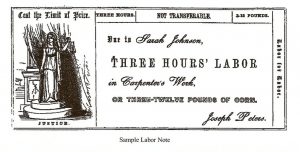Early Anarchist Ideas
Josiay Warren and the Cincinnati Time Store
 Josiah Warren , A sample labor for labor note for the Cincinnati Time Store (1846)
Josiah Warren , A sample labor for labor note for the Cincinnati Time Store (1846)
The Cincinnati Time Store was a store created by the individualist anarchist Josiah Warren to test his theories that were based on the labor theory of value, which says that the value of a commodity is the amount of labor that goes into producing or acquiring it (and this theory of value is also shared by the vast majority of socialist and anarchist of this era). The experimental store is the first place where notes for labor were used. In the store, customers could purchase goods with “labour notes” which represented an agreement to perform labour. This was determined on the principle of the equal exchange of labour, measured by the time taken, and exchanged hour for hour with other kinds of labour. Warren embraced the labour theory of value, which says that the value of a commodity is the amount of labour that goes into producing or acquiring it. Warren summed up this policy in the phrase “Cost the limit of price,” with “cost” referring to the amount of labour one exerted in producing a good. He set out to examine if his theories could be put into practice by establishing his “labour for labour store.” His experiment proved to be successful.From this, he concluded that it was therefore unethical to charge more labor for a product than the labor required to produce it.
Feminism and Anarchism
Worcester Daily Spy, “Anarchist Shoot by Sweetheart”, Page 1 (1902)
Feminism was almost a creation of anarchist intellectuals. That is what anarchist history can tell at a very first sight. One of the pioneer’s feminists of all time was Voltairine de Cleyre. Voltairine de Cleyre (the most gifted and brilliant anarchist woman America ever produced, as Emma Goldman noted) was an anarchist known for being a prolific writer and speaker, and opposing capitalism, the state, marriage, and the domination of religion over sexuality and women’s lives. It was Voltairine who pioneered feminist theory on economic independence for women, autonomy inside and outside marriage; the impact of oppression on women’s social status, economic status, and consciousness, women’s ownership of their own bodies and the role of the church and state in oppressing women. This newspaper article notices what Cleyre has been shooted by a “sweetheart”, perhaps a jealous lover that could not stand her free way of living.
Emma Goldman
Emma Goldman stands as a major figure in the history of American radicalism and feminism. An influential and well known anarchist of her day, Goldman was an early advocate of free speech, birth control, women’s equality and independence, and union organization. Her criticism of mandatory conscription of young men into the military during World War I led to a two year imprisonment, followed by her deportation in 1919. For the rest of her life until her death in 1940, she continued to participate in the social and political movements of her age, from the Russian Revolution to the Spanish Civil War.
The Propaganda of the Deed

Alexander Berkman’s attempt to assassinate industrialist Henry Clay Frick, W. P. Snyder for Harper’s Weekly (1892)
The Propaganda of the deed is the political action meant to be exemplary to others and serve as a catalyst for revolution. It is associated with acts of violence perpetrated by proponents of insurrectionary including bombings and assassinations against the ruling class. These “deeds” were to ignite the spirit of revolt in the people by demonstrating the state was not omnipotent and by offering hope to the downtrodden, and to expand support for anarchist movements as the state grew more repressive in its response. In 1892, as the illustration shows and undertaking an act of propaganda of the deed, the anarchist Alexander Berkman made an unsuccessful attempt to assassinate businessman Henry Clay Frick.
